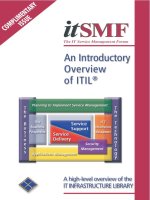The IT Infrastructure Library An Introductory Overview of ITIL® V3 pot
Bạn đang xem bản rút gọn của tài liệu. Xem và tải ngay bản đầy đủ của tài liệu tại đây (646.33 KB, 58 trang )
The IT Service Management Forum
An Introductory
Overview of ITIL
®
V3
Published in association with the
Best Management Practice Partnership
A high-level overview of the
IT INFRASTRUCTURE LIBRARY
The IT Infrastructure Library
An Introductory
Overview of ITIL® V3
Version 1.0
Written by: Alison Cartlidge Xansa - Steria
Ashley Hanna HP
Colin Rudd itEMS Ltd
Ivor Macfarlane IBM
John Windebank Sun
Stuart Rance HP
Edited by: Alison Cartlidge Xansa - Steria
Mark Lillycrop itSMF UK
Published by: The UK Chapter of the itSMF
With thanks to all those who took part in the review process.
© Copyright itSMF Ltd, 2007
This version first published 2007
Based on other copyright material with the permission of the copyright
owners.
ITIL® is a Registered Trade Mark, and a Registered Community Trade Mark,
of the Office of Government Commerce (OGC) and is registered in the US
Patent and Trade Mark Office.
PRINCE® is a Registered Trade Mark, and a Registered Community Trade
Mark, of the Office of Government Commerce (OGC) and is registered in the
US Patent and Trade Mark Office.
COBIT® is a Registered Trade Mark of ISACA and the ITGA.
CMM® is registered in the USA Patent and Trademark Office.
PMBoK® is a Registered Trade Mark of the Project Management Institute.
M_o_R ® is a Registered Trade Mark and a Registered Community Trade
Mark of the Office of Government Commerce.
© Crown copyright material reproduced with the kind permission of OGC on
behalf of the Controller of Her Majesty’s Stationery Office (HMSO).
The Swirl logoTM is a Trademark of the Office of Government Commerce.
ISBN 0-9551245-8-1
1
2
ITIL (IT Infrastructure Library) provides a framework of Best Practice
guidance for IT Service Management and since its creation, ITIL has grown to
become the most widely accepted approach to IT Service Management in the
world.
This pocket guide has been designed as an introductory overview for anyone
who has an interest in or a need to understand more about the objectives,
content and coverage of ITIL. Whilst this guide provides an overview, full
details can be found in the actual ITIL publications themselves.
This guide describes the key principles of IT Service Management and provides
a high-level overview of each of the core publications within ITIL:
■
Service Strategy
■
Service Design
■
Service Transition
■
Service Operation
■
Continual Service Improvement.
An overview of the qualifications scheme is also included.
The advice contained within this guide is neither definitive nor prescriptive, but
is based on ITIL Best Practice. The guidance in the ITIL publications is
applicable generically and is of benefit to all IT organizations irrespective of
their size or the technology in use. It is neither bureaucratic nor unwieldy if
utilized sensibly and in full recognition of the business needs of the
organization.
About this guide
About this Guide 2
Contents 3
1 Introduction 4
2 What is Service Management? 6
3 What is ITIL? 8
4 Service Strategy 12
5 Service Design 18
6 Service Transition 24
7 Service Operation 29
8 Continual Service Improvement 35
9 Process Cross Reference 41
10 Qualifications 43
11 Related Standards and Other Sources 47
12 Summary 49
Further Guidance and Contact Points 51
Best Practice within ITIL 52
About itSMF 53
About the Partnership 54
3
Contents
4
It has become increasingly recognized that information is the most important
strategic resource that any organization has to manage. Key to the collection,
analysis, production and distribution of information within an organization is
the quality of the IT Services provided to the business. It is essential that we
recognize that IT Services are crucial, strategic, organizational assets and
therefore organizations must invest appropriate levels of resource into the
support, delivery and management of these critical IT Services and the IT
systems that underpin them. However, these aspects of IT are often overlooked
or only superficially addressed within many organizations.
Key issues facing many of today’s senior Business Managers and IT Managers
are:
■
IT and business strategic planning
■
Integrating and aligning IT and business goals
■
Implementing continual improvement
■
Measuring IT organization effectiveness and efficiency
■
Optimizing costs and the Total Cost of Ownership (TCO)
■
Achieving and demonstrating Return on Investment (ROI)
■
Demonstrating the business value of IT
■
Developing business and IT partnerships and relationships
■
Improving project delivery success
■
Outsourcing, insourcing and smart sourcing
■
Using IT to gain competitive advantage
■
Delivering the required, business justified IT services (i.e. what is required,
when required and at an agreed cost)
■
Managing constant business and IT change
■
Demonstrating appropriate IT governance.
The challenges for IT managers are to co-ordinate and work in partnership with
the business to deliver high quality IT services. This has to be achieved while
adopting a more business and customer oriented approach to delivering
services and cost optimization.
1 Introduction
The primary objective of Service Management is to ensure that the IT services
are aligned to the business needs and actively support them. It is imperative
that the IT services underpin the business processes, but it is also increasingly
important that IT acts as an agent for change to facilitate business
transformation.
All organizations that use IT depend on IT to be successful. If IT processes and
IT services are implemented, managed and supported in the appropriate way,
the business will be more successful, suffer less disruption and loss of
productive hours, reduce costs, increase revenue, improve public relations and
achieve its business objectives.
Key sections within this guide:
■
Section 4 overviews Service Strategy: The achievement of strategic goals or
objectives requires the use of strategic assets. The guidance shows how to
transform service management into a strategic asset.
■
Section 5 overviews Service Design: guidance on designing IT services,
along with the governing IT practices, processes and policies, to realize the
strategy and facilitate the introduction of services into the live environment
ensuring quality service delivery, customer satisfaction and cost-effective
service provision.
■
Section 6 overviews Service Transition: guidance for the development of
capabilities for transitioning new and changed services into operations,
ensuring the requirements of Service Strategy, encoded in Service Design,
are effectively realized in Service Operations while controlling the risks of
failure and disruption.
■
Section 7 overviews Service Operation: guidance on achieving effectiveness
and efficiency in the delivery and support of services to ensure value for
the customer and the service provider. Strategic objectives are ultimately
realized through Service Operations.
■
Section 8 overviews Continual Service Improvement: guidance in creating
and maintaining value for customers through better design, introduction
and operation of services, linking improvement efforts and outcomes with
Service Strategy, Design, Transition and Operation.
■
Section 10 Qualifications provides an outline of the current and proposed
qualification scheme.
5
6
To understand what service management is, we need to understand what
services are, and how service management can help service providers to deliver
and manage these services.
A service is a means of delivering value to customers by
facilitating outcomes customers want to achieve without the
ownership of specific costs and risks.
A simple example of a customer outcome that could be facilitated by an IT
service might be: “Sales people spending more time interacting with
customers” facilitated by “a remote access service that enables reliable access
to corporate sales systems from sales people’s laptops”.
The outcomes that customers want to achieve are the reason why they purchase
or use the service. The value of the service to the customer is directly dependent
on how well it facilitates these outcomes. Service management is what enables
a service provider to understand the services they are providing, to ensure that
the services really do facilitate the outcomes their customers want to achieve, to
understand the value of the services to their customers, and to understand and
manage all of the costs and risks associated with those services.
Service Management is a set of specialized organizational
capabilities for providing value to customers in the form of
services.
These “specialized organizational capabilities” are described in this pocket
guide. They include all of the processes, methods, functions, roles and activities
that a Service Provider uses to enable them to deliver services to their
customers.
Service management is concerned with more than just delivering services. Each
service, process or infrastructure component has a lifecycle, and service
management considers the entire lifecycle from strategy through design and
transition to operation and continual improvement.
2 What is IT Service Management?
The inputs to service management are the resources and capabilities that
represent the assets of the service provider. The outputs are the services that
provide value to the customers.
Effective service management is itself a strategic asset of the service provider,
providing them with the ability to carry out their core business of providing
services that deliver value to customers by facilitating the outcomes customers
want to achieve.
Adopting good practice can help a service provider to create an effective service
management system. Good practice is simply doing things that have been
shown to work and to be effective. Good practice can come from many different
sources, including public frameworks (such as ITIL, COBIT and CMMI),
standards (such as ISO/IEC 20000 and ISO 9000), and proprietary knowledge
of people and organizations.
7
8
ITIL is a public framework that describes Best Practice in IT service
management. It provides a framework for the governance of IT, the ‘service
wrap’, and focuses on the continual measurement and improvement of the
quality of IT service delivered, from both a business and a customer
perspective. This focus is a major factor in ITIL’s worldwide success and has
contributed to its prolific usage and to the key benefits obtained by those
organizations deploying the techniques and processes throughout their
organizations. Some of these benefits include:
■
increased user and customer satisfaction with IT services
■
improved service availability, directly leading to increased business profits
and revenue
■
financial savings from reduced rework, lost time, improved resource
management and usage
■
improved time to market for new products and services
■
improved decision making and optimized risk.
ITIL was published between 1989 and 1995 by Her Majesty’s Stationery Office
(HMSO) in the UK on behalf of the Central Communications and
Telecommunications Agency (CCTA) – now subsumed within the Office of
Government Commerce (OGC). Its early use was principally confined to the
UK and Netherlands. A second version of ITIL was published as a set of
revised books between 2000 and 2004.
The initial version of ITIL consisted of a library of 31 associated books covering
all aspects of IT service provision. This initial version was then revised and
replaced by seven, more closely connected and consistent books (ITIL V2)
consolidated within an overall framework. This second version became
universally accepted and is now used in many countries by thousands of
organizations as the basis for effective IT service provision. In 2007, ITIL V2
was superseded by an enhanced and consolidated third version of ITIL,
consisting of five core books covering the service lifecycle, together with the
Official Introduction.
3 What is ITIL?
The five core books cover each stage of the service lifecycle (Figure 1), from the
initial definition and analysis of business requirements in Service Strategy and
Service Design, through migration into the live environment within Service
Transition, to live operation and improvement in Service Operation and
Continual Service Improvement.
9
Figure 1: The service lifecycle
Figure 2: Complementary publications
Continual
Service
Improvement
Knowledge
& skills
Governance
methods
Standards
alignment
Case
Studies
Quick
wins
Scalability
Update
service
Executive
introduction
Study
Aids
Qualifications
Speciality
topics
Templates
Service
Transition
Service
Strategy
Continual
Service
Improvement
Continual
Service
Improvement
Service
Design
Service
Operation
ITIL
Continual Service
Improvement
Continual Service
Improvement
Continual Service
Improvement
Service
Design
Service
Strategy
Service
Transition
Service
Operation
The five books are described in more detail in the following sections of this
pocket guide. A sixth book, the Official Introduction, offers an overview of the
five books and an introduction to IT Service Management as a whole.
The core books are the starting point for ITIL V3. It is intended that the content
of these core books will be enhanced by additional complementary publications
and by a set of supporting web services (Figure 2). In addition, the ITIL V3
Process Model will be made available via the www.itil-live-portal.com website.
10
These additional sources of information will provide:
■
knowledge and skills: information on the experience and knowledge
needed to exploit (and gained through) ITIL
■
speciality topics: specific areas of interest, such as outsourcing
■
templates
■
governance methods: details of methods that have been successfully used
to govern Service Management systems and activities
■
standards alignment: information on the alignment of ITIL with
international standards
■
executive introduction: introductory guides for executives and senior
managers on the benefits and value of using ITIL
■
study aids: additional guides that can be used by students studying ITIL,
particularly on accredited training courses
■
qualifications: a set of qualifications based around the core publications
and their use within the industry
■
quick wins: details of potential quick wins and benefits that can be
obtained from the adoption of ITIL practices
■
scalability: how to scale service management implementation for specific
organizations, such as very small or very large businesses
■
update service: a web-based service providing regular updates on the
progress and ongoing development of ITIL.
All service solutions and activities should be driven by business needs and
requirements. Within this context they must also reflect the strategies and
policies of the service provider organization, as indicated in Figure 3.
The diagram illustrates how the service lifecycle is initiated from a change in
requirements in the business.
These requirements are identified and agreed within the Service Strategy stage
within a Service Level Package (SLP) and a defined set of business outcomes.
This passes to the Service Design stage where a service solution is produced
together with a Service Design Package (SDP) containing everything
necessary to take this service through the remaining stages of the lifecycle.
The SDP passes to the Service Transition stage, where the service is evaluated,
tested and validated, the Service Knowledge Management System (SKMS) is
updated, and the service is transitioned into the live environment, where it
enters the Service Operation stage.
Wherever possible, Continual Service Improvement identifies opportunities for
the improvement of weaknesses or failures anywhere within any of the lifecycle
stages.
11
Figure 3: Key links, inputs & outputs of the service lifecycle stages
The Business / Customers
Requirements
Strategies
Solution Designs
Transition Plans
Tested solutions
Operational Plans
Operational services
SKMS updated
Architectures
Standards
SDPs
Policies
Resource
and constraints
SLPs from
Requirements
Service
Strategy
Service
Design
Service
Transition
Service
Operation
Continual
Service
Improvement
Service Knowledge Management System (SKMS)
Including the Service Portfolio and Service Catalogue
Improvement
actions & plans
12
Purpose
The service strategy of any service provider must be grounded upon a
fundamental acknowledgement that its customers do not buy products, they
buy the satisfaction of particular needs. Therefore, to be successful, the services
provided must be perceived by the customer to deliver sufficient value in the
form of outcomes that the customer wants to achieve.
Achieving a deep understanding of customer needs, in terms of what these
needs are, and when and why they occur, also requires a clear understanding of
exactly who is an existing or potential customer of that service provider. This,
in turn, requires the service provider to understand the wider context of the
current and potential market places that the service provider operates in, or
may wish to operate in.
A service strategy can not be created or exist in isolation of the over-arching
strategy and culture of the organization that the service provider belongs to. The
service provider may exist within an organization solely to deliver service to one
specific business unit, to service multiple business units, or may operate as an
external service provider serving multiple external businesses. The strategy
adopted must provide sufficient value to the customers and all of the service
provider’s stakeholders – it must fulfill the service provider’s strategic purpose.
Irrespective of the context in which the service provider operates, its service
strategy must also be based upon a clear recognition of the existence of
competition, an awareness that each side has choices, and a view of how that
service provider will differentiate itself from the competition. All providers
need a service strategy.
Hence, the Service Strategy publication sits at the core of the ITIL V3 lifecycle.
It sets out guidance to all IT service providers and their customers, to help them
operate and thrive in the long term by building a clear service strategy, i.e. a
precise understanding of:
■
what services should be offered
■
who the services should be offered to
4 Service Strategy
■
how the internal and external market places for their services should be
developed
■
the existing and potential competition in these marketplaces, and the
objectives that will differentiate the value of what you do or how you do it
■
how the customer(s) and stakeholders will perceive and measure value, and
how this value will be created
■
how customers will make service sourcing decisions with respect to use of
different types of service providers
■
how visibility and control over value creation will be achieved through
financial management
■
how robust business cases will be created to secure strategic investment in
service assets and service management capabilities
■
how the allocation of available resources will be tuned to optimal effect
across the portfolio of services
■
how service performance will be measured.
Key Concepts
The Service Strategy publication defines some key ITIL concepts.
The four Ps of Strategy:
■
perspective: the distinctive vision and direction
■
position: the basis on which the provider will compete
■
plan: how the provider will achieve their vision
■
pattern: the fundamental way of doing things – distinctive patterns in
decisions and actions over time.
Competition and Market Space:
■
every service provider is subject to competitive forces
■
all service providers and customers operate in one or more internal or
external market spaces. The service provider must strive to achieve a better
understanding than its competitors of the dynamics of the market space,
its customers within it, and the combination of critical success factors that
are unique to that market space.
13
14
Service Value: defined in terms of the customer’s perceived business
outcomes, and described in terms of the combination of two components:
■
Service Utility: what the customer gets in terms of outcomes supported
and/or constraints removed
■
Service Warranty: how the service is delivered and its fitness for use, in
terms of availability, capacity, continuity and security.
Service Value also includes the associated concepts of services as Assets, Value
Networks, Value Creation and Value Capture.
Service Provider Types:
■
Type I: exists within an organization solely to deliver service to one specific
business unit
■
Type II: services multiple business units in the same organization
■
Type III: operates as an external service provider serving multiple external
customers.
Service Management as a Strategic Asset: the use of ITIL to
transform service management capabilities into strategic assets, by using
Service Management to provide the basis for core competency, distinctive
performance and durable advantage, and increase the service provider’s
potential from their:
■
capabilities: the provider’s ability (in terms of management, organization,
processes, knowledge and people) to coordinate, control and deploy
resources
■
resources: the direct inputs for the production of services, e.g. financial,
capital, infrastructure, applications, information and people.
Critical Success Factors (CSFs): the identification, measurement and
periodic review of CSFs to determine the service assets required to successfully
implement the desired service strategy.
Service Oriented Accounting: using financial management to understand
services in terms of consumption and provisioning, and achieve translation
between corporate financial systems and service management.
Service Provisioning Models: categorization and analysis of the various
models that may be selected by customers and used by service providers to
source and deliver services, and the financial management impacts of on-shore,
off-shore or near-shore variants:
■
Managed Service: where a business unit requiring a service fully funds the
provision of that service for itself
■
Shared Service: the provisioning of multiple services to one or more
business units through shared infrastructure and resources
■
Utility: services are provided on the basis of how much is required by each
customer, how often, and at what times the customer needs them.
Organization Design and Development: achieving an ongoing shape
and structure to the service provider’s organization that enables the service
strategy. Considerations include:
■
Organizational Development Stages: delivering services through network,
direction, delegation, coordination or collaboration depending on the
evolutionary state of the organization
■
Sourcing Strategy: making informed decisions on service sourcing in terms
of internal services, shared services, full service outsourcing, prime
consortium or selective outsourcing
■
Service Analytics: using technology to help achieve an understanding of
the performance of a service through analysis
■
Service Interfaces: the mechanisms by which users and other processes
interact with each service
■
Risk Management: mapping and managing the portfolio of risks
underlying a service portfolio.
Key Processes and Activities
In addition to Strategy Generation, Service Strategy also includes the following
key processes.
Financial Management
Financial Management covers the function and processes responsible for
managing an IT service provider’s budgeting, accounting and charging
requirements. It provides the business and IT with the quantification, in
financial terms, of the value of IT services, the value of the assets underlying the
provisioning of those services, and the qualification of operational forecasting.
15
16
IT Financial Management responsibilities and activities do not exist solely
within the IT finance and accounting domain. Many parts of the organization
interact to generate and use IT financial information; aggregating, sharing and
maintaining the financial data they need, enabling the dissemination of
information to feed critical decisions and activities.
Service Portfolio Management (SPM)
SPM involves proactive management of the investment across the service
lifecycle, including those services in the concept, design and transition pipeline,
as well as live services defined in the various service catalogues and retired
services.
SPM is an ongoing process, which includes the following:
■
Define: inventory services, ensure business cases and validate portfolio
data
■
Analyze: maximize portfolio value, align and prioritize and balance supply
and demand
■
Approve: finalize proposed portfolio, authorize services and resources
■
Charter: communicate decisions, allocate resources and charter services.
Demand Management
Demand management is a critical aspect of service management. Poorly
managed demand is a source of risk for service providers because of
uncertainty in demand. Excess capacity generates cost without creating value
that provides a basis for cost recovery.
The purpose of Demand Management is to understand and influence customer
demand for services and the provision of capacity to meet these demands. At a
strategic level this can involve analysis of patterns of business activity and user
profiles. At a tactical level it can involve use of differential charging to
encourage customers to use IT services at less busy times.
A Service Level Package (SLP) defines the level of utility and warranty for a
Service Package and is designed to meet the needs of a pattern of business
activity.
Key Roles and Responsibilities
The Service Strategy publication defines some specific roles and
responsibilities associated with the execution of a successful service strategy,
including:
■
Business Relationship Manager (BRM): BRMs establish a strong
business relationship with the customer by understanding the customer's
business and their customer outcomes. BRMs work closely with the
Product Managers to negotiate productive capacity on behalf of customers.
■
Product Manager (PM): PMs take responsibility for developing and
managing services across the life-cycle, and have responsibilities for
productive capacity, service pipeline, and the services, solutions and
packages that are presented in the service catalogues.
■
Chief Sourcing Officer (CSO): the CSO is the champion of the sourcing
strategy within the organization, responsible for leading and directing the
sourcing office and development of the sourcing strategy in close
conjunction with the CIO.
17
18
Purpose
Service Design is a stage within the overall service lifecycle and an important
element within the business change process. The role of Service Design within
the business change process can be defined as:
The design of appropriate and innovative IT services, including
their architectures, processes, policies and documentation, to
meet current and future agreed business requirements.
The main goals and objectives of Service Design are to:
■
design services to meet agreed business outcomes
■
design processes to support the service lifecycle
■
identify and manage risks
■
design secure and resilient IT infrastructures, environments, applications
and data/information resources and capability
■
design measurement methods and metrics
■
produce and maintain plans, processes, policies, standards, architectures,
frameworks and documents to support the design of quality IT solutions
■
develop skills and capability within IT
■
contribute to the overall improvement in IT service quality.
Key Principles
Service Design starts with a set of business requirements, and ends with the
development of a service solution designed to meet documented business
requirements and outcomes and to provide a Service Design Package (SDP) for
handover into Service Transition.
There are 5 individual aspects of Service Design:
■
new or changed service solutions
■
service management systems and tools, especially the Service Portfolio
■
technology architectures and management systems
■
processes, roles and capabilities
■
measurement methods and metrics.
5 Service Design
A holistic approach should be adopted in Service Design to ensure consistency
and integration in all IT activities and processes, providing end-to-end
business-related functionality and quality. Good service design is dependent
upon the effective and efficient use of the Four Ps of Design:
■
people: the people, skills and competencies involved in the provision of IT
services
■
products: the technology and management systems used in the delivery of
IT services
■
processes: the processes, roles and activities involved in the provision of IT
services
■
partners: the vendors, manufacturers and suppliers used to assist and
support IT service provision.
Service Design Package (SDP): defines all aspects of an IT service and
its requirements through each stage of its lifecycle. An SDP is produced for
each new IT service, major change, or IT service retirement.
Key Processes and Activities
Service Catalogue Management (SCM)
The Service Catalogue provides a central source of information on the IT
services delivered to the business by the service provider organization,
ensuring that business areas can view an accurate, consistent picture of the IT
services available, their details and status.
The purpose of Service Catalogue Management (SCM) is to provide a single,
consistent source of information on all of the agreed services, and ensure that it
is widely available to those who are approved to access it.
The key information within the SCM process is that contained within the
Service Catalogue. The main input for this information comes from the Service
Portfolio and the business via either the Business Relationship Management or
the Service Level Management processes.
Service Level Management (SLM)
SLM negotiates, agrees and documents appropriate IT service targets with the
business, and then monitors and produces reports on delivery against the
agreed level of service.
19
20
The purpose of the SLM process is to ensure that all operational services and
their performance are measured in a consistent, professional manner
throughout the IT organization, and that the services and the reports produced
meet the needs of the business and customers.
The main information provided by the SLM process includes Service Level
Agreements (SLA), Operational Level Agreements (OLA) and other support
agreements, and the production of the Service Improvement Plan (SIP) and the
Service Quality Plan.
Capacity Management
Capacity Management includes business, service and component capacity
management across the service lifecycle. A key success factor in managing
capacity is ensuring that it is considered during the design stage.
The purpose of Capacity Management is to provide a point of focus and
management for all capacity and performance-related issues, relating to both
services and resources, and to match the capacity of IT to the agreed business
demands.
The Capacity Management Information System (CMIS) is the cornerstone of a
successful Capacity Management process. Information contained within the
CMIS is stored and analyzed by all the sub-processes of Capacity
Management for the provision of technical and management reports, including
the Capacity Plan.
Availability Management
The purpose of Availability Management is to provide a point of focus and
management for all availability-related issues, relating to services, components
and resources, ensuring that availability targets in all areas are measured and
achieved, and that they match or exceed the current and future agreed needs of
the business in a cost-effective manner.
Availability Management should take place at two inter-connected levels and
aim to continually optimize and proactively improve the availability of IT
services and their supporting organization. There are two key aspects:
■
reactive activities: monitoring, measuring, analysis and management of
events, incidents and problems involving service unavailability
■
proactive activities: proactive planning, design, recommendation and
improvement of availability.
Availability Management activities should consider the availability, reliability,
maintainability and serviceability at both service and component level,
particularly those supporting Vital Business Functions (VBFs).
The Availability Management process should be based around an Information
System (AMIS) that contains all of the measurements and information required
to provide the appropriate information to the business on service levels. The
AMIS also assists in the production of the Availability Plan.
IT Service Continuity Management (ITSCM)
As technology is a core component of most business processes, continued or
high availability of IT is critical to the survival of the business as a whole. This
is achieved by introducing risk reduction measures and recovery options. On-
going maintenance of the recovery capability is essential if it is to remain
effective.
The purpose of ITSCM is to maintain the appropriate on-going recovery
capability within IT services to match the agreed needs, requirements and
timescales of the business.
ITSCM includes a series of activities throughout the lifecycle to ensure that,
once service continuity and recovery plans have been developed, they are kept
aligned with Business Continuity Plans and business priorities.
The maintenance of appropriate ITSCM policy strategies and ITSCM plans
aligned with business plans is key to the success of an ITSCM process. This
can be accomplished by the regular completion of Business Impact Analysis
and Risk Management exercises.
Information Security Management (ISM)
ISM needs to be considered within the overall corporate governance
framework. Corporate governance is the set of responsibilities and practices
exercised by the board and executive management with the goal of providing
strategic direction, ensuring that the objectives are achieved, ascertaining that
the risks are being managed appropriately, and verifying that the enterprise’s
resources are used effectively.
21
22
The purpose of the ISM process is to align IT security with business security
and ensure that information security is effectively managed in all service and
Service Management activities, such that:
■
information is available and usable when required (availability)
■
information is observed by or disclosed to only those who have a right to
know (confidentiality)
■
information is complete, accurate and protected against unauthorized
modification (integrity)
■
business transactions, as well as information exchanges, can be trusted
(authenticity and non-repudiation).
ISM should maintain and enforce an overall policy, together with a set of
supporting controls within an integrated Security Management Information
System (SMIS), aligned with business security policies and strategies.
Supplier Management
The Supplier Management process ensures that suppliers and the services they
provide are managed to support IT service targets and business expectations.
The purpose of the Supplier Management process is to obtain value for money
from suppliers and to ensure that suppliers perform to the targets contained
within their contracts and agreements, while conforming to all of the terms and
conditions.
The Supplier and Contract Database (SCD) is a vital source of information on
suppliers and contracts and should contain all of the information necessary for
the management of suppliers, contracts and their associated services.
Key Service Design stage activities
■
Business requirements collection, analysis and engineering to ensure they
are clearly documented.
■
Design and development of appropriate service solutions, technology,
processes, information and measurements.
■
Production and revision of all design processes and documents involved in
Service Design.
■
Liaison with all other design and planning activities and roles.
■
Production and maintenance of policies and design documents.
■
Risk management of all services and design processes.
■
Alignment with all corporate and IT strategies and policies.
Key Roles and Responsibilities
The key roles involved within the Service Design activities and processes are:
■
Service Design Manager: responsible for the overall coordination and
deployment of quality solution designs for services and processes
■
IT Designer/Architect: responsible for the overall coordination and design
of the required technologies, architectures, strategies, designs and plans
■
Service Catalogue Manager: responsible for producing and maintaining an
accurate Service Catalogue
■
Service Level Manager: responsible for ensuring that the service quality
levels are agreed and met
■
Availability Manager: responsible for ensuring that all services meet their
agreed availability targets
■
IT Service Continuity Manager: responsible for ensuring that all services
can be recovered in line with their agreed business needs, requirements and
timescales
■
Capacity Manager: responsible for ensuring that IT capacity is matched to
agreed current and future business demands
■
Security Manager: responsible for ensuring that IT security is aligned with
agreed business security policy risks, impacts and requirements
■
Supplier Manager: responsible for ensuring that value for money is
obtained from all IT suppliers and contracts, and that underpinning
contracts and agreements are aligned with the needs of the business.
23
24
Purpose
The role of Service Transition is to deliver services that are required by the
business into operational use. Service Transition delivers this by receiving the
Service Design Package from the Service Design stage and delivering into the
Operational stage every necessary element required for ongoing operation and
support of that service. If business circumstances, assumptions or requirements
have changed since design, then modifications may well be required during the
Service Transition stage in order to deliver the required service.
Service Transition focuses on implementing all aspects of the service, not just
the application and how it is used in ‘normal’ circumstances. It needs to ensure
that the service can operate in foreseeable extreme or abnormal circumstances,
and that support for failure or errors is available. This requires sufficient
understanding of:
■
potential business value and who it is delivered to/judged by
■
identification of all stakeholders within supplier, customer and other areas
■
application and adaptation of service design, including arranging for
modification of the design, where the need is detected during transition.
Key Principles
Service Transition is supported by underlying principles that facilitate effective
and efficient use of new/changed services. Key principles include:
■
Understanding all services, their utility and warranties - to transition a
service effectively it is essential to know its nature and purpose in terms of
the outcomes and/or removed business constraints (utilities) and the
assurances that the utilities will be delivered (warranties).
■
Establishing a formal policy and common framework for implementation of
all required changes - consistency and comprehensiveness ensure that no
services, stakeholders, occasions etc. are missed out and so cause service
failures.
■
Supporting knowledge transfer, decision support and re-use of processes,
systems and other elements – effective Service Transition is delivered by
involving all relevant parties, ensuring appropriate knowledge is available
and that work done is reusable in future similar circumstances.
6 Service Transition









